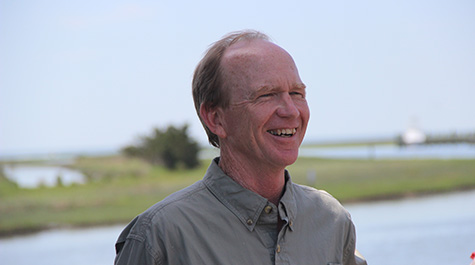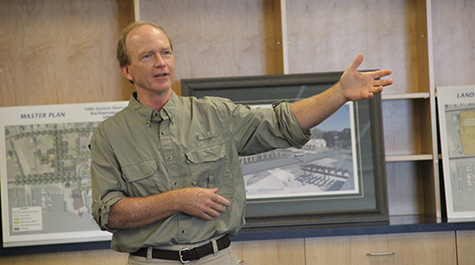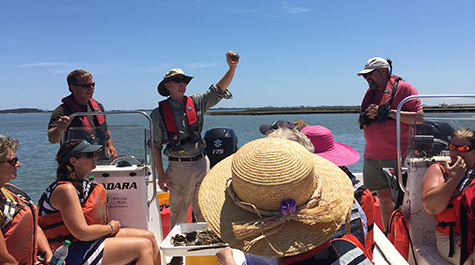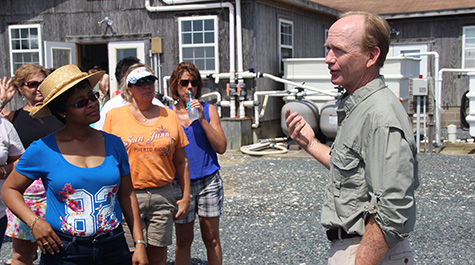VIMS welcomes new Director of Eastern Shore Laboratory
Snyder brings fresh ideas, perspective to Wachapreague
The Virginia Institute of Marine Science recently welcomed Dr. Richard Snyder as the new Director of its Eastern Shore Laboratory in Wachapreague. Snyder replaces Dr. Mark Luckenbach, who was named Associate Dean of Research and Advisory Services on the Institute’s Gloucester Point campus in 2013.
During the two years since Luckenbach made the transition to VIMS’ main campus, P.G. Ross, a marine scientist at the ESL, had stepped in as Interim Director while a national search for a new director was underway. Snyder comes to VIMS from the University of West Florida in Pensacola where he served as Director of its Center for Environmental Diagnostics and Bioremediation.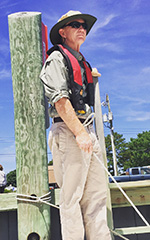
VIMS Dean and Director John Wells says, “Dr. Snyder is a wonderful addition to our administration. He brings a wealth of experience, a clear vision, and incredible enthusiasm. I’m looking forward to working with him.”
As Director of the ESL, Snyder is responsible for ensuring that visiting students and faculty have safe and effective access to the coastal habitats of the Eastern Shore, and that ESL facilities capitalize on that access for optimal classroom and experimental work. Snyder says he is looking forward to picking up where Luckenbach and Ross left off in terms of expanding the campus and further enhancing its role as a hub for research and teaching.
While he says he is thrilled to take on his responsibilities as director, Snyder says he also finds it extremely important that he stay engaged in research and educational activities. “I’m definitely going to be writing grants and getting involved in research,” he says. “I love how small the ESL is, and how everyone works together. I’m a big team player, so if I’m needed on field trips or to help move tables for one of our monthly seminars, I’m there to pitch in. That is the kind of atmosphere that is important to me.”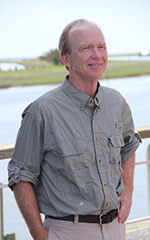
Luckenbach says, “Dr. Synder brings a strong research background in coastal marine science, a history of teaching at the graduate, undergraduate, and public education levels, and experience in program administration that is a perfect fit for the ESL. I am very pleased welcome him to VIMS and I think he makes a great addition to our faculty.”
One of the first initiatives Snyder plans to implement at the ESL is a new molecular biology lab, which is slated to reside within Seaside Hall. “It’s something that can be used at multiple levels and in multiple fields,” he says. “It represents new capabilities for visiting and resident researchers. It will allow us to provide molecular diagnostics in support of aquaculture industry, water quality for human health, and support basic research.”
Snyder says the new lab is just one of his ideas for establishing the ESL as a year-round research enterprise. “If we can get this place going so that research is sustained year-round, we can provide more jobs for local students to stay here, in addition to being able to bring in highly trained scientists,” he says. “Anything I can do to keep local talent and bring new talent to the area and the ESL, I will do. I want to bring in intellectual currency and elevate the level of discussion and expertise in the area, which I think is important to the local economy.”
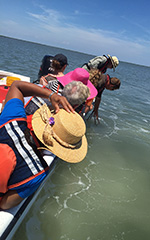 Originally from Chestertown, Maryland, Snyder describes his arrival on the shore as coming home. “I’ve wanted to work on the Eastern Shore since I was in graduate school, but there aren’t many opportunities for scientists here,” he says. “I love Chesapeake Bay’s coastal and mid-Atlantic habitats, and I learned all of the flora and fauna before I left, so I’m getting reacquainted with it now. I’m really immersing myself in the system and it’s great to be back.”
Originally from Chestertown, Maryland, Snyder describes his arrival on the shore as coming home. “I’ve wanted to work on the Eastern Shore since I was in graduate school, but there aren’t many opportunities for scientists here,” he says. “I love Chesapeake Bay’s coastal and mid-Atlantic habitats, and I learned all of the flora and fauna before I left, so I’m getting reacquainted with it now. I’m really immersing myself in the system and it’s great to be back.”
A broadly trained interdisciplinary ecologist, Snyder says his research focuses mostly on microbial ecology, especially that of eukaryotic microbes. “I’ve also worked with plant community ecology in coastal acidic bogs and barrier islands, and have conducted studies on the spatial and species-specific distributions and concentrations of metals, PAHs, PCBs, and dioxins and furans in fish and shellfish.”
Snyder says he feels obliged to allocate time to explaining complex science to the general public through media contacts and presentations, and to improve the dynamics of the science-society interface.
“VIMS has always had a commitment to service and I’ve always liked that,” he says. “I’ve spent a lot of my career getting out in the public and providing science for local issues. I think it’s our responsibility as scientists to communicate our research through public information and outreach, and that is something I admire about VIMS, because that’s how they’ve done it since the very beginning.”


